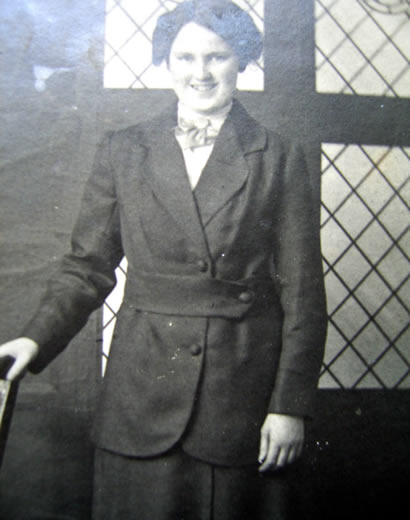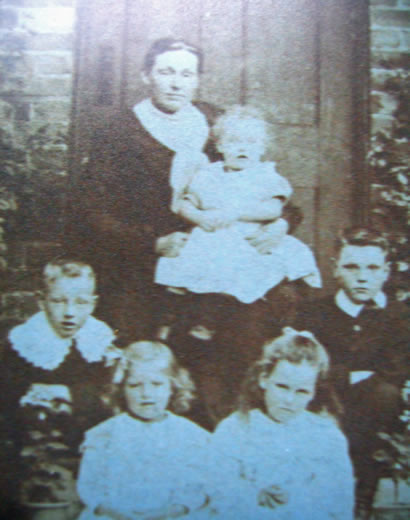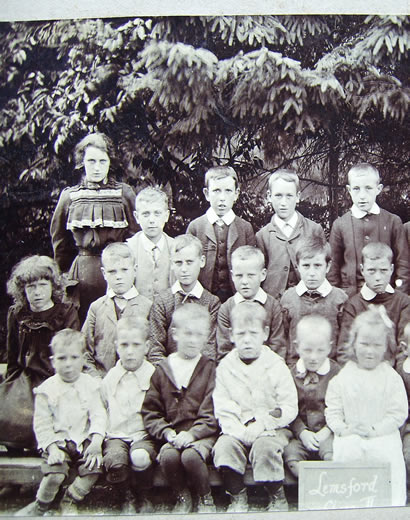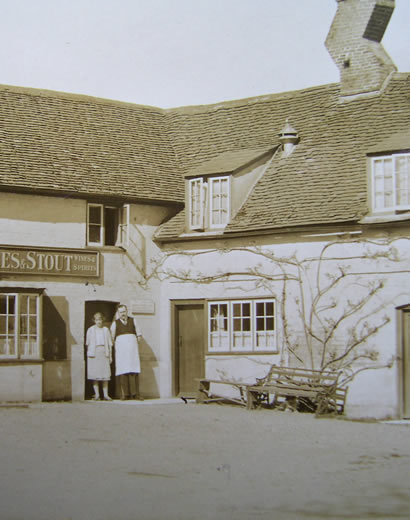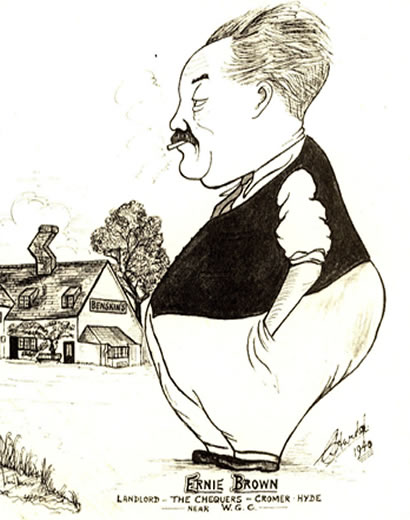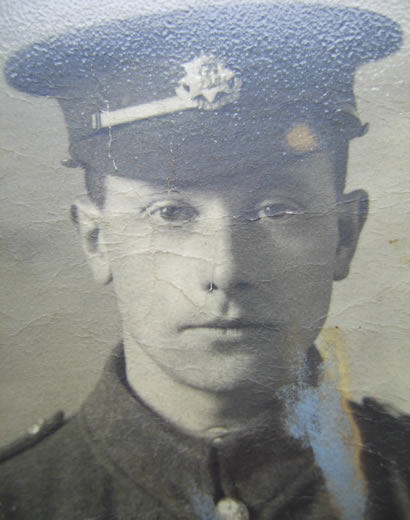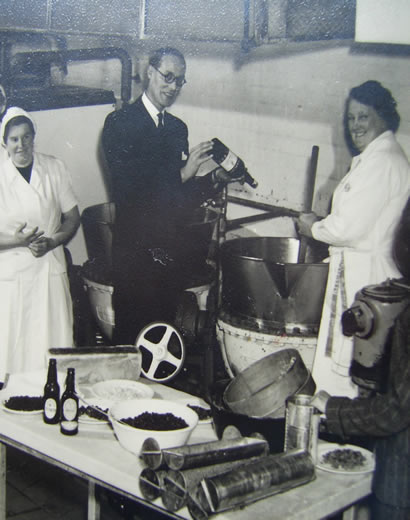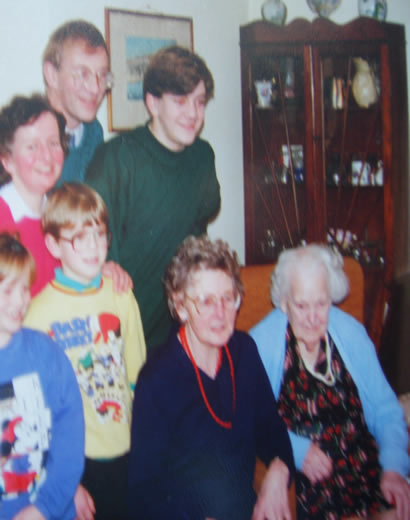May Hawkins (nee Brown) 1899 to 1998
Of all my aunts and uncles, and Mum came from a family of six and Dad from a family of eleven, it was my dear Auntie May that I knew the best, probably because for most of my life she had lived not too far away. When I was young in South London , she had lived at Peckham and would often come and see us. In North London too she would visit and we would go to see her. In later life when Eileen and I had Sue and Rob at Enfield she would come and look after Mum when we went on holiday , and later still when I had a car we would go to Pinner every five or six weeks to pay a visit .All those years we would listen to her wonderful stories of the "old days" and I not only made notes but got some of it on tape. This story has therefore been written in memory of her and I hope they portray some of her eventful life that stretched from the final years of Queen Victoria to her death at the age of 99.
To enjoy all the Images Click on Large image and then the arrow for slide show
With three older brothers, she was the first to be born of twins, with her brother Percy, (See Slide two of Images above) in an old semi detached cottage at the end of Cromer Hyde lane near Lemsford, Herts. It was a tithe cottage, as my Grandfather was gamekeeper for Lord Mount Stephen of Brocket, and was very basic with two rooms up and two down, no services and water had to be brought from a well down the lane. This was a job done with a yoke by the boys, when they were big enough. As the family grew Granny and Grandad slept in one room with the youngest child and the children slept in the other ,boys in one bed and girls in the other. She was the first daughter so I expect her three older brothers would have been in one room and the twins would have been in with their parents.
Life in the cottage must have been as basic as the accommodation, but was the lot of most working class country folk. The garden was large and they grew all their own vegetables. Grannie was the daughter of a Victorian head gardener who had at one time worked for Sir Arthur Sullivan at Staghanoe, St. Pauls Walden and she was a very good gardener herself. Only the small front garden was used for flowers and she loved to collect seeds and cuttings, with or without the consent of the owner of the plant. They had a pigsty at the back and when the pig was ready it would be slaughtered and cut up by the local butcher so that it could be treated with salt wrapped in old curtains and kept until it was ready. The children used to collect acorns , when in season, to feed the pig and even made a few pennies by selling them to neighbours at a penny a pottle, an old measure about a gallon. Cooking was on a large stove , always alight, burning wood they collected and coal when they could afford it.
Lemsford school about 1904, May sixth from left front row. (See Slide three of Images above) Village life at that time was much as it had been for generations. In the case of Lemsford the local squire was Lord Mount Stephen and his wife who were an elderly childless couple. He had made his name and money by his association with the construction of the Canadian Pacific Railway and they were very wealthy and ran Brocket accordingly. The Prince of Wales ,later George V often visited for the shooting. For which it was well known. Lady Mount Stephen was a friend of the future Queen Mary.
The old couple took a great interest in the village including the school, and visited it often. Children were expected to show respect when they met them and the girls curtsied and the boys raised their caps. Failure to do so might get back to their parents who probably worked for His Lordship and if it did get back, they were in trouble. At Christmas Lord Mount Stephen arranged for crates of lovely red Canadian apples to be shipped over for distribution to the children. He also gave a length of material to the girls, so their mothers could make them dresses and gave a jersey to each boy that was then handed down through the family.
They also took an active interest in the welfare of the children and on the occasion when five of my aunts and uncles had to have their tonsils out, which was often done on a day visit to the hospital, he sent his coach and coachman to take Grannie and children to Hertford and wait to bring them back. Unfortunately, Percy was ill afterwards and had to stay in and it was decided that May would stay with him for company until he was better. In a couple of days he improved and the coach and coachman returned to bring them home and on the way Percy was sick all over the expensive linings in the coach .Grannie was worried about what his Lordship would say but apparently he told her not to worry and had it all cleaned to its original condition. Another time he arranged for my Father to have an operation for his deafness and it was a complete success---I only heard about it years later after my Father had died.
The Chequers in the thirties. E Brown in doorway with wife (See Slide Four of Images above)The more or less centre of the little community was the pub that stood at the corner of the lane and the road to Wheathampstead. Originally it had been two or three cottages, but when farm labourers began to get a little more money to spend and beer houses became popular, in the early 19th century , they had been made into one as a pub and called "The Chequers“(changed to The Crooked Chimney in modern times).This popular name originally came from a beer that was brewed from the chequered bark of a woodland tree but I do not think it has anything to do with our Chequers. When the Wheathampstead Point to Point races were held they attracted a lot of punters from London and one famous music hall star used to go there with lots of friends in a horse drawn brake. On the way home in a merry condition they would stop at the Chequers to get even more merry and when they boarded the brake to go home they would throw handfuls of pennies to the waiting children who knew what usually happened. Some parents forbade their children to go to such an exhibition but lots did , including May and her brothers and sisters much to Grannies displeasure.
Another of her stories of the old pub was of the farm labourer who lived up the lane and on Friday when he was paid spent all the evening at the pub until closing time. His poor wife would then come to meet him to get him home and bring rags to bind his knees so that as he crawled home he didn’t wear his trousers out !!
Ernie Brown In the 1930s (See Slide Six of Images above) when my Uncle Ernst Brown was the landlord it still retained its rural character and often locals would pay for a pint with goods such as a rabbit. Noawadays it is a very modernised enlarged road house and the name has been changed to "The Crooked Chimney" because of the bent chimney that still remained from one of the old cottages. Nowadays all the farm labourers have moved to WGC , my Grannies old cottage has been demolished and others have been transformed into desirable commuter properties.
When she was about five years old she and her brother Percy joined her older brothers at Lemsford school, about two and a half miles from home. It had been built in the 19th century by the wealthy Desborough family, who had built others in Hertfordshire including one at Birch Green, near Hertford, where by coincidence my Mother went. Both are still there today enlarged and modernised. Originally Lemsford catered for about 100 pupils from the surrounding countryside, children of estate workers, farms and farm labourers. All the children walked to school, some a very long way, and most stayed to lunch bringing sandwiches etc. because it was long before school lunches which didn’t come until after the second world war.The children were divided up into age groups for classes but there were several classes in one large room. Young children used slates and the older ones had pencils, pens and paper. There were books that could be borrowed, many of which came from Lord and Lady Mount Stephen.
Mr Ladbury. headmaster at Lemsford from 1902 to 1936 (See Slide Seven of Images above)The Headmaster was Mr Ladbury and his wife was referred to as the Governess. There were three teachers, the Miss Eva and Margaret Lines and Miss Carry Clark. Discipline was strict with no talking or whispering, and the main punishment was caning and a little room you were sent to reflect on your misdemeanours. The older girls were encouraged to do needle work for the "Waifs and Strays" with material provided mostly by the Mount Stephens. On a lighter note there were school outings to Alexandra Palace in North London by horse drawn brake and once by train to Southend.
At home as the eldest girl she helped her mother with the younger children but this did not seem to upset her great love for children she had all her life. On Sundays the family would go to church in the morning and the children to Sunday school in the afternoon. On occasions they would all go to see their grandparents at St Pauls Walden about seven or eight miles away. The visit would have been pre arranged by postcard (only a half penny in those days) and they would start out in the morning walking by lane and footpath to get the most direct route. In those days it was common to see a family walking in a long line, parents and little ones in front and older children at the back. There would have been a good lunch waiting for them when they got there with a rest in the afternoon before the long walk home before dark. One of her stories was that Grannie Deamer used to say that Percy used to teach the chickens how to escape from the run !!
When she was about twelve she started work on a daily basis as nursemaid for the Vicar of Lemsfords new baby boy. By that time she had helped her mother and knew a lot about children and she would have been an efficient nursemaid. The vicars name was the Rev Ward and the baby she looked after was Stephen Ward who in later years became famous (or infamous) for his part in the Profumo scandal.
Her next job was as "between" maid at Dr Drages in Hatfield and for this she lived in. On her day off she would walk home and on one occasion when Percy came to meet her and walk her home, they went into the old "Bull" at Stanborough which then stood on the west side of the old Great North Road (later it was demolished and now stands on the west of the A1M Editors Note: It was Knocked down in 2019 and he knows the man who drank the last pint ever) There they had a glass of ginger beer but when they left she left her gloves there. The publican later told Grandfather about the gloves so he then knew they had been in the pub and they were suitably told off.
It was about this time that the family,who had lived for so long in the old cottage at the end of Cromer Hyde lane, moved to a new house further down nearer to the Wheathampstead road. This time it had water laid on but not other facilities
Otterburn Hall In those days there were employment agencies for domestic staff in towns and cities, but very often in the case of junior staff at large country estates, the master or mistress would hear of likely youngsters whose parents worked for their friends. In this case, Lady Mount Stephen heard that her friend, Lady Morrison Bell wanted a girl to work in the kitchen at her country home Otterburn Hall near Bournemouth, and recommended her gamekeepers daughter, who she knew was looking for a better position. It was arranged that she would go and see if she was suitable. She was thirteen years old.
Grandfather took her and her wickerwork case up to London Kings Cross and then across to Waterloo to catch the train for Bournemouth. She had only been as far as St. Albans on market days and Hatfield and it must have been quite an experience to be left alone on the Bournemouth train. She often recalled that she had long dark hair and wore a label with her details on the lapel of her coat and she must have felt very lonely. At Bournemouth she was met by the coachman of Otterburn Hall and he was a big smart man in coachman’s uniform with a top hat and long polished boots. He asked if she was the young lady for the Hall and then whisked her away to her new home.
There she was taken in to the cook, a large formidable lady who took her to the kitchen and gave her food and drink. She was then introduced to two girls in the kitchen before being spruced up and taken upstairs to meet Lady Morrison Bell who's immediate reaction was that she would have to have her hair cut. During the following interview she was asked what she felt about working at the hall and May , who had been very impressed with the size of the house , said she didn’t think she could keep all the windows clean ! Lady Bell laughed and said that would not be one of her jobs and the outcome was she was accepted onto the staff in the cooks care.
Like most wealthy people at that time the Bells had a London home in Grovesner Square, another in Scotland for the shooting season, and the one at Bournemouth. The staff there consisted of :-
Butler, 2 Footmen, Housekeeper, Cook, Head maid, 3 Kitchen girls, Page boy, House boy, 4 Housemaids, Odd job man, Coachman, 2 Ladies maids, Steward , Head gardener, 6 bothy boys.(She always referred to garden labourers as " bothy boys " )
She was given a shared room with one of the other kitchen girls and she happily settled in to her new life. Being very bright she learnt fast and was liked by the older girls and caused much amusement in the kitchen with her youthful innocence. For example, she referred to a cockerel as a "father bird " because she thought it rude to call it a cock. Part of her work was to keep all the pots and pans clean and once when the cook asked where the clear soup had gone she said she thought it was dirty water and had thrown it away and washed the pot. On another occasion the cook asked if she could clean and prepare a hare, and she quickly claimed she could because my grannie had shown her how to deal with many shot rabbits that grandfather had brought home. Having done a good job she proudly presented it to the cook who asked where its ears were. Apparently at that time roasted hare was always taken to the table with its ears on so she had to go and find them and sew them back on. When she saw the cook drop the lobsters alive into boiling water and watched them turn red it made her cry, and the first time she cooked asparagus she threw the wrong part away. Her antics endeared her to the older girls and she loved to talk about it in later years.
When she got her first months money she felt very rich and on her afternoon off she went down into Bournemouth and blew the lot buying one of the large fancy hats that were so popular at that time, and proudly showed it off to the kitchen staff. The cook was appalled that she had spent all her money on such a frivolous item and said she should have sent some home to her mother who had "all those children " to feed. For the rest of her time at the Hall, cook only let her have a little pocket money and saved the rest until she went home. Can't see that happening today !
Her next appointment was as second kitchen maid at Lord and Lady Dynever in Berkeley Square, who also owned Dynever Castle in Cornwall and a house in Yorkshire. At this time my parents lived in Thrush St , Southwark, not too far away and she was a frequent visitor , and got to know London quite well.
She then moved to Chatsworth House in Derbyshire where she became second kitchen maid for the Duke and Duchess of Devonshire. They also had Devonshire House in Piccadilly . At that time the Duke was Governor General of Canada. They were very rich people and she often recalled the splendours of Chatsworth. Years later when Eileen and I visited Chatsworth we had tea in the restaurant which used to be the old kitchen and all round the walls there were highly polished pots and pans. We sent the old lady a postcard which showed all the pots and she recalled polishing them for hours on end. She even recalled the home made polish they used containing silver sand.
Hatfield HouseFrom there she went to work for Lord Salisbury at Hatfield House where she was first kitchen made, and much nearer her home at Cromer Hyde. The Salisburys also were very rich people and in Victorian days a special station was built for them in a siding next to the main Hatfield station and it was used by the Family and Royal visitors. I remember it well when I was a boy but it all went when Hatfield station was redeveloped about 1960.
She used to talk about the magnificent banquets when the family silver normally kept in vaults in London was sent to Hatfield by rail and unpacked and polished by footmen under the watchful eye of the butler before displaying it on the banqueting table. When she worked in the old kitchen at Hatfield House, the cook was a very overbearing lady and on one important occasion she told May to put one of the silver salvers in the big wall oven and to watch it until it got warm. May did what she was told but after a time the cook told her to do something else. She pointed out that she was watching the oven but cook said that would be all right and to do as she was told. Having done that ,she went back to the oven and was horrified to find that part of the salver had melted. Cook was furious and in spite of Mays protestations said it would have to be reported to Lord Salisbury. Next day , full of fear, May went to his Lordships study and he asked her to tell him about it. He listened to her tearful story and probably realised that it was not her fault. He smiled and told her not to worry and that the salver would be sent to the silversmith to be remade so it all ended happily.
About 1970 we picked her up and took her for a visit to Hatfield House for a memory lane trip. We joined a party of people with an old retainer as our guide and to Auntie Mays delight she remembered him from nearly sixty years ago and he remembered her. It was delightful to hear the two old folks recalling the days of their youth in the Hatfield House complex. When we visited the old kitchen it was no longer used as such but all the old ranges and ovens were still there including the one she put the silver dish in. In those days when a family moved from, say, their London house to their Country house they moved all best china etc and staff in private carriages and sometimes private trains.
She must have been highly thought of at the Salisburys as her next post was as cook for Lady Mary Caselle, Lord Salisbury's daughter, when she married the son of the Duke of Devonshire, at Hardwicke Hall, Derbyshire. She often used to tell us of the magnificent staircase and when we visited it with the travel club in later years we were able to see it and tell her all about it.
The next post was as cook for Lady Hambledon at Greenlands, Henley on Thames. This family had a London House in Grosvenor Square and another country house at Morton Hamsted in Devon, which had been used as a hospital in the Great War. She then went back to the Duchess of Devonshire at Pembroke Lodge, Richmond Park and there she met Arthur Hawkins who was a footman.(See Slide Eight of Images above) He had been in service as a footman before the war, and was in the army in Mesopotamia before coming back to service when the war ended. I remember him as a very kind man with a good sense of humour. In those days he was troubled by a large growth right in the middle of his forehead that looked as big as a pigeons egg .He never did anything about it and one day he hit his head on a tap which punctured it and it all dispersed, leaving a little dent in his forehead for the rest of his life We used to ask her about how male and female servants got on and it seems as though officially there was strictly no fraternisation. Beneath the surface however lots of friendships were formed, as you would expect, and at night it was not unknown for servants to climb out of windows and slip down to the local town or village for a few hours. Her friendship with Arthur developed and she used to tell one story that portrayed the power of the butler in these big establishments. Apparently, they took the family dog for a walk and ventured into an isolated part of the estate where they had no right to go, and the dog got its paw caught in a trap that gamekeepers used to use in those days. When they got back they had to explain to the butler and he was furious and said it had to be reported to Her Ladyship. They were then taken before the Duchess and explained what had happened. The butler wanted them sacked but the Duchess, who had only been married a short while herself , realised they were fond of each other and had meant no harm. She laughed the whole thing off, and much to the butlers disgust, they were not punished in any way. They eventually left to get married in 1924.
Arthur in the army (See Slide Nine of Images above)They decided to leave service all together and moved to a house in Camberwell, again not far from where we lived, and Arthur became an insurance salesman. At that time Dagenham was being developed and they got a small council house there Unfortunately, after a time he fell ill with a disease he had picked up in the army in the Middle East, and was six months off work. May got temp work and when he was better they decided to go back to service as a cook and butler pair.
One of their jobs was with Tom Walls (See Slide Ten of Images above) and Ralph Lynn and she used to amuse us with stories about the antics of these famous actors who made their name in farce on the west end stage. One particular story of Ralph Lynn tossing a pancake and sticking it on the ceiling was her favourite.
Another job was for Mr. Batty, in Adelphi Square, the equerry to the Prince of Wales, later Edward the 8th, before he met Mrs Simpson . There were many parties attended by the Prince and the Duchess of Connaught who was a very beautiful lady. It was about this time that Uncle Arthur, who knew I was beginning to have a passion for woodwork, made me a tool box that I treasured for many years.
In the late thirties they took a cook and butler post with Mr and Mrs Keith of Clothall House, Baldock and again they were highly thought of. When the war broke out the Keiths went to Canada and wanted to take them with them but regulations at that time prevented them going and they had to go into industry for the war effort.
In th kitchens at Kodak May got a job as cook in the main Kodak factory at Pinner (See Slide Eleven of Images above) and Arthur got work in the packing department. They moved to a new council flat nearby and spent some happy years there. At Kodak they soon realised what a good cook and organiser she was and she was soon promoted to be in charge of kitchens and restaurant. In 1948 when there was still rationing she made us a lovely three tier wedding cake and they came to our wedding.
With sister Ivy 1990s Sadly Arthur died in the fifties but Auntie kept on at Kodak for many years. She used to go to the Kodak Hotel at the coast for a holiday and they used to send a car for door to door service. In those days when Sue and Rob were young and we used to go away with them for a week, Auntie May used to come to Elmer Close to look after Nan and sometimes Auntie Eva came too. She moved to a smaller flat, and then eventually moved to an old peoples flat with a warden where she was very happy. All this time her mind was quite clear and her memory good but as she got into her nineties she was not so mobile and used to have a help every day , eventually to get her up and get her meals. She was always a joy to visit and never complained and talked about reaching 100 but it was not to be and after a short illness died in her ninety ninth year. She would have made a lovely Mum and always loved babies and children and we will always remember her.
All images and text are owned by H.J.Brown. Permission must be obtained from H.J.Brown to reproduce any of the material on this site. Contact H.J.Brown


